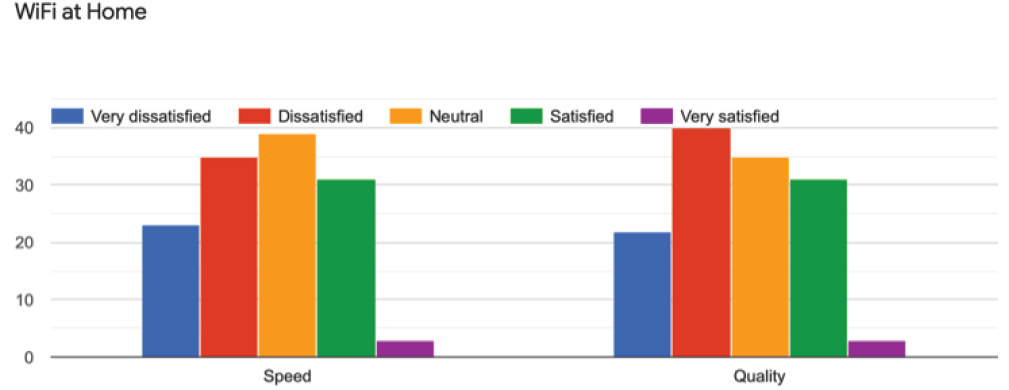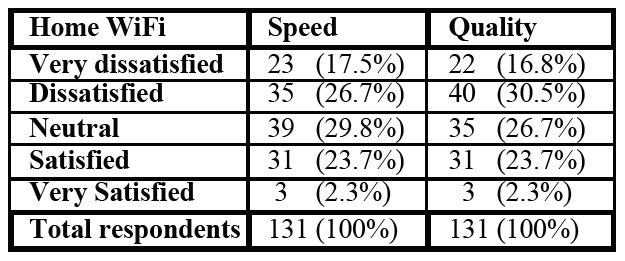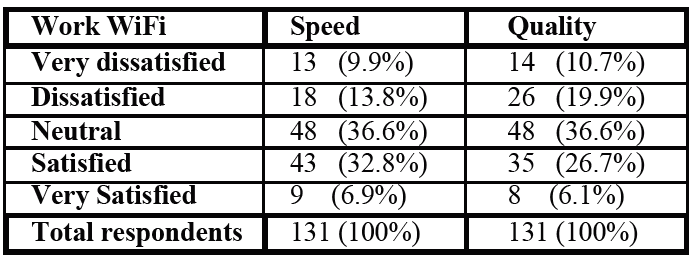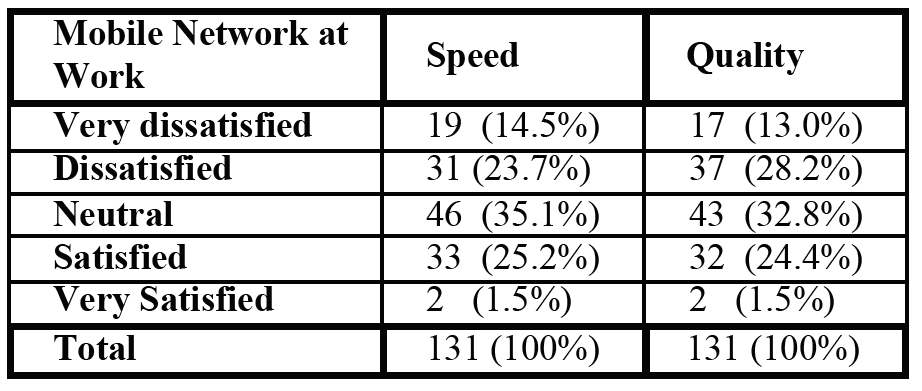EXECUTIVE SUMMARY
- An online targeted survey to evaluate internet connectivity speed and quality across Penang was carried out from May 2021 to June 2021 by Digital Penang and Penang Institute. A total of 131 responses were collected.
- The study shows that experiences of WiFi and mobile networks generally fare better at work than at home. Understandably, work institutions invest much more in their internet connectivity to support the volume of gadgets used on their premises; however, when a majority of individuals now work from home and share their broadband with the rest of the household, residential areas call for urgent boosts in the quality and speed of internet connections at home.
- Video conferencing is the most used streaming service among the respondents (80%), followed by social media livestreaming (56.2%), Netflix (32.3%), Astro (19.2%), and on-demand video streaming (18.5%).
- Expanding fiber networks, and if possible, expanding the reach of 5G connectivity state-wide needs to be a top priority in the state government’s response to the New Normal, a concern that had been strong and undeniable even before Covid-19.
INTRODUCTION
Since the onset of the Covid-19 pandemic, attending virtual meetings, online classes, and even catching up with loved ones via online calls have become crucial in our lives. Lockdowns also mean that people spend more time online for entertainment purposes, be it streaming episodes on Netflix, gaming online, surfing different social media platforms, or indulging in some online shopping. Even procuring daily necessities such as groceries and meals online have become a norm.
In February 2020, just before the Covid-19 pandemic began and before the change in government at the federal level, the Penang state government launched 19 5G-demonstration projects worth RM23.2million, with the collaboration of seven telco companies. The projects were an initial step towards fully rolling out 5G connectivity (Malay Mail, 2020). In mid-2020, Digital Penang (DP) was formed to spearhead, plan and organize the digitalisation of the economy and of governance, and to enhance the digital literacy of Penang’s inhabitants. In early 2021, Digital Penang publicized the Digital Transformation Masterplan (DTMP) for the state to highlight these ambitions.
With the support of Digital Penang, Penang Institute conducted an online targeted survey from 11 May 2021 to 20 June 2021 to assess the satisfaction of Penang users on the internet connectivity that they experience at home and at work, for both their WiFi and Mobile connections. Data was also collected on the streaming services that they use, the number of devices they have at home, and the number of persons living in their households, in order to gauge the level of home usage of the internet.
The Respondent Breakdown
Where home use is concerned, residents from Bayan Lepas, Gelugor, Sungai Dua, and Batu Maung (postcode 11900) make up the majority of the respondents, at 19.1%. They are followed by those living in George Town and Jelutong (postcode 11600), at 11.5%. As much as 8.4% of respondents live within postcode 11700 which includes other parts of Gelugor, George Town, and Jelutong; 7.6% of respondents are from Tanjung Bungah and Tanjung Tokong (postcode 11200) while residents of Air Itam and Bukit Bendera (postcode 11500) make up 6.9% of out of the total of 131 respondents. The rest are scattered across all other parts of Penang.
Where workplace connections are concerned, people working in Bayan Lepas, Gelugor, Sungai Dua, Batu Maung (postcode 11900) make up the majority (13%), followed by those working in Perai, Bukit Mertajam and Seberang Perai (postcode 13600), at 9.9%; Jelutong (postcode 10300) at 8.4%; and George Town (postcode 10350) at 7.6%. The rest of the respondents either work at other areas of Penang or are currently not working.
WIFI CONNECTIVITY SATISFACTION
Respondents were asked to rate their satisfaction level with the WiFi quality and speed they experience at home and at work. WiFi quality refers to the signal strength, whereas WiFi speed determines how fast files are uploaded and downloaded.
Figure 1: Comparison of satisfaction levels in WiFi Speed and Quality at Home
Table 1: Satisfaction levels for WiFi Speed and Quality at Home, in percentage
The survey shows more user dissatisfaction (44.3%) than satisfaction (26%) with the WiFi speed that respondents experience at home. Correspondingly, more respondents are dissatisfied (47.1%) than satisfied (26%) with the WiFi quality at home. The rest of the respondents were neutral about their home WiFi condition.
Figure 2: Comparison of satisfaction levels in WiFi Speed and Quality at Work
Table 2: Satisfaction levels for WiFi Speed and Quality at Work, in percentage
Meanwhile at work places, respondents are mostly neutral (36.6%) about the WiFi speed they experience, with more being satisfied (39.7%) than dissatisfied (23.7%). When it comes to the WiFi quality at work, a similar size, 36.6%, of respondents feel neutral, while 32.8% are satisfied and 30.6% dissatisfied.
Responses show that the WiFi connection at workplaces are generally stronger than at home. This may be because companies tend to subscribe to more powerful broadband packages to sustain the volume of connectivity needed, compared to residential users. Based on the postcodes and addresses provided for workplaces, a substantial portion of the respondents work at the Industrial Free Trade Zones in Bayan Lepas and Prai. It is reasonable to infer that the WiFi connectivity in these areas are acceptable but can still be improved. On the other hand, the WiFi reception in residences is generally poor state-wide. Given that a majority of respondents are residents on the island, it appears that home WiFi connection is not up to par even in urban areas
MOBILE NETWORK EXPERIENCE
Respondents were asked to rate their satisfaction with their mobile network quality and speed at home and at work.
Figure 3: Comparison of satisfaction levels in Mobile Network Speed and Quality at Home
Table 3: Satisfaction levels for Mobile Network Speed and Quality at Home, in percentage
Equally many respondents are neutral as are dissatisfied with the speed and quality of their mobile network at home. To be sure, more respondents lean towards being very dissatisfied with the speed (51.1%) and quality (54.2%) of the mobile network at home than being satisfied with the speed (20.7%) and quality (19.1%).
Figure 4: Comparison of satisfaction levels in Mobile Network Speed and Quality at Work
Table 4: Satisfaction levels for Mobile Network Speed and Quality at Work, in percentage
The experience of mobile network at workplaces is slightly better compared to that at home. A majority of respondents are neutral about the speed (35.1%) and quality (32.8%) of their mobile network when used at their workplace. In terms of speed, 14.5% of respondents are very dissatisfied, 23.7% dissatisfied, 25.2% satisfied, while an insignificant 1.5% are very satisfied. Somewhat similarly, respondents rate the quality of their mobile network at work to be very unsatisfactory (13%), unsatisfactory (28.2%), satisfactory (24.4%), and very satisfactory (1.5%).
The four most popular telcos in Malaysia are Maxis, Celcom, Digi, and U Mobile. Respondents’ strong sentiment of being discontented with their mobile network at home points to the need for telcos to improve reception speed and quality at residential areas.
STREAMING SERVICES
Respondents were asked to state the streaming services they use, with multiple choices allowed.
Figure 5: Distribution of streaming services used
Video conferencing platforms such as Zoom, Microsoft Teams, and Google Meet were the most used streaming services among the respondents (80%). This is unsurprising as virtual meetings and online classes for work and school now rely heavily on these platforms. This is followed by social media livestreaming platforms such as Facebook live, Instagram live, and YouTube live (56.2%), which are now popularly used to broadcast virtual events and product promotions live, with the option for viewers to interact on-the-spot with hosts. Entertainment streaming media providers like Netflix (32.3%), Astro (19.2%), and on-demand video streaming (18.5%) are also heavily used.
URGENT NEED FOR IMPROVEMENTS
A crisis is a time when weaknesses are revealed, and priorities are changed. While the Covid-19 pandemic has accelerated the process of digitalisation in the region and the world, raising public consciousness of that need along the way, it has also exposed how much, or how little government bodies, private institutions and individuals have adapted to the realities of a digital economy.
Online meetings and classes are undoubtedly here to stay even when the pandemic abates. This means that the quality of internet connections will decide how a society and a country manages in a world of instant global messaging and information transfer.
The Penang state government, conscious of this global trend, had already in 2018 published its wish to enhance the digitalisation process; and by the time Covid-19 came, had already laid the groundwork for its digitalisation agency, Digital Penang, to be formed. In that sense, it is mentally prepared for the acceleration in digitalisation processes in the state. Digital connectivity is a top priority, and the half-good half-bad experiences of the Penang public when going online is concerned justifies this policy focus, and in fact, gives added urgency to it.
The state’s immediate goal should therefore be about maximising digital connectivity, both to stimulate economic growth and innovativeness as well as to provide acceptably reliable digital connectivity as a 21st century public utility to all households. The “smart state” that Penang2030 envisions has become a more urgent ambition.
Below are certain suggestions for how this process can be speeded up.
1. Encourage self-regulation by telco companies to improve their network
While efforts are currently being taken by state agencies to improve internet connectivity and digital literacy, these require time and resources to fulfil. It is therefore imperative that telco companies self-regulate in order to improve their networks. Seeing as there are a number of key players in the telco industry in the country, keen competition in gaining customers should encourage these companies to constantly put in effort to improve their services.
2. Focus on end users
Digitalisation in the public sector should focus on the needs of the end user (Baldock, 2020). Data collected on network quality (such as this report) strategically provide targeted information on the experiences of end users, considering these to be most revealing of the factual infrastructure situation. The pandemic, making work and study possible only is done online, has elevated the need for fast and good internet connection. This makes end user experiences all the more crucial as a source of information. Additionally, the retail industry today relies heavily on good internet connection, and more and more shopping, be it of handbags or food, are done online (Cochoy et.al., 2017).
3. Address the digital divide
A Sabah student having to stay atop a tree in order to receive 3G reception to sit for her exams made the news in June 2020. This was a painful reminder to all authorities and players involved of the tremendous gap in the availability of internet across the country.
This present survey also reveals significant differences in quality of internet connections, even in urban areas. The gap in Penang between those who have internet access and those who do not, or hardly have any can be strongly assumed to be much worse. This survey, being done online because of the pandemic, could not study that reality.
4. Increase Collaboration between Administrative Levels
The National Fiberisation and Connectivity Plan (NFCP) 2019-2023 aims to improve the nation’s broadband quality and coverage, reduce broadband prices, and provide internet access for all (MyGovernment, 2019). On both the federal and state levels, it is crucial to push for high-speed fiberisation in order to improve connectivity in the country (OECD, 2020). To that end, coordination between state and federal policies is vital.
5. Improve physical and regulatory infrastructure
One of Penang2030’s strategic initiatives is to strengthen the state’s mobility, connectivity, and digital infrastructure. Another closely related strategy is to integrate municipal services with smart technologies. These goals, if achieved, will undoubtedly make working, living, and dealing with official matters much more convenient for all. Improvements in physical and regulatory infrastructure, as well as infrastructure sharing and co-investments by the state, telco companies, electronic and data technology companies would also go a long way.
For list of references, kindly download the document to view.
Editor: Ooi Kee Beng
Editorial Team: Sheryl Teoh, Alexander Fernandez and Nur Fitriah (Designer)
Image by Frederik Lipfert (Unsplash)
You might also like:

Protecting Women: An Overview of Women’s Legal Rights in Southeast Asia

TVET in Malaysia: Current Situation, Challenges and Recommendations

The Skills Gap Remains Penang’s Big Challenge

On the Many Non-Economic Benefits of Flexible Work Arrangements

George Town Heritage Celebrations: Achievements and Reflections











